“The Raft of the Medusa,” while maintaining the symmetry of Poussin, changes painting once and for all. It is sculptural and architectural, but depicts no architecture. Two great overlapping triangles, suggesting both a ship’s sails and the ocean’s waves, define the space. They also contain 19 human figures (one barely visible, four others quite obscure) in various postures, combinations and stages of life: the living, the dying and the dead, old and young, black and white, male and—perhaps—female. Some have faces; others turn away from us. We can read the painting both from left to right and from bottom to top.
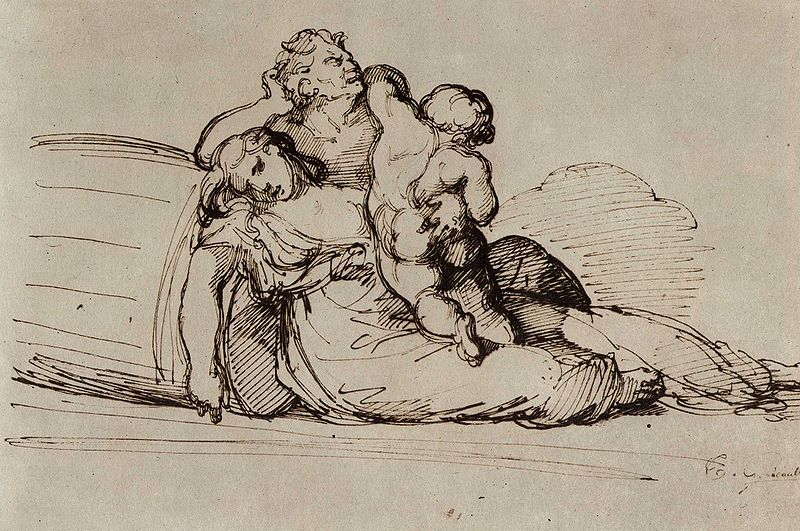
Théodore Géricault: Study for 'the Raft of the Medusa', ink over pencil on paper, 203x299 cm Date c.1818
It is a colossal canvas by any stretch; sixteen feet high and twenty-three feet wide, and if you stand fairly close to it, ‘you already feel as though you had one foot in the water” , as Delacroix said after attending its debut at the Paris Salon of 1819. Unlike most of the overblown and boring salon pictures of the epoch, its size is not in inverse proportion to its historical importance. Theodore Gericault’s ”Raft of the Medusa” launched the romantic movement in French painting just as decisively as Victor Hugo’s ”Hernani” rang up the curtain on the romantic theatre and Hector Berlioz’s ”Symphonie Fantastique” proclaimed a new age of romantic music.
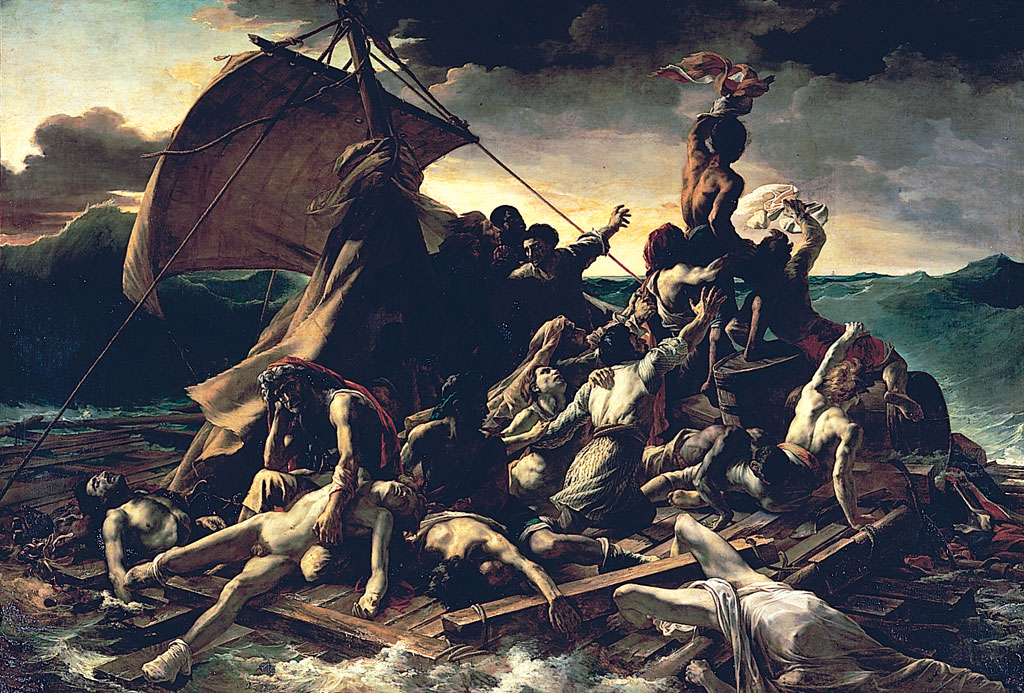
''In expressing the predicament of the shipwrecked everywhere in the world, Géricault had laid the foundations of an aesthetic revolution. The Raft of the Medusa marks the first appearance in painting of 'the ugly' and thereby proclaims its scrupulous respect for the truth, however repulsive the truth might be. This concern for truth is integral to the Romantic temperament. For his Salon picture in 1819, Géricault chose a dramatic episode — the wreck of the frigate Meduse, which had set off with a French fleet on an expedition to Senegal, and had been lost in July 1816. The French admiralty was accused of having put an incompetent officer in charge of the expedition; he was the Comte de Chaumareix, a former emigre who had not commanded a vessel for twenty-five years. The picture was an enormous success, more on account of the scandal than because of an interest in the arts; but Géricault only received a gold medal, and his picture was not bought by the government. One wonders who it was suggested commissioning this painter of horror subjects to do a Sacred Heart. Géricault was mortified, and decided to exhibit his picture in England, where a pamphlet had been published on the wreck of the Meduse. He entrusted the vast canvas to an eccentric character named Bullock (as Lethière had done with his Brutus Condemning his Sons), and it was exhibited in London from 12 June to 31 December 1820, and in Dublin from 5 February to 31 March 1821. Géricault received a third of the takings, and the operation brought him in quite a large sum (probably 20,000 francs).''
Gericault, however, was a full ten years ahead of the others, which made his task correspondingly difficult and his leap all the more spectacular. His particular contribution to romanticism has to do with style and technique, but above all with the artist’s emotional involvement as an ”homme engage” . His predecessors had painted beautifully affirmative pictures of the Church or the party in power, such as Jacques-Louis David’s portraits of Napoleon.
Gericault, who would have belonged to the opposition party no matter what the issue, chose to be a protest painter long before protest and dissent had become a familiar and even fashionable way of art. He put fifteen shipwrecked men and four corpses on a raft in mid-ocean and held them up to view as an indictment of the crimes and blunders that were responsible for their ordeal. At one stroke he realized all the rebel ambitions that the young painters of his generation had been talking about. Instead of a classical subject, he was dealing with a current event; in place of stylized nudes there were flesh and blood bodies in postures of suffering and death. If this was an allegory of the human condition, no wonder the critics accused him of being a man without a sense of the beautiful.
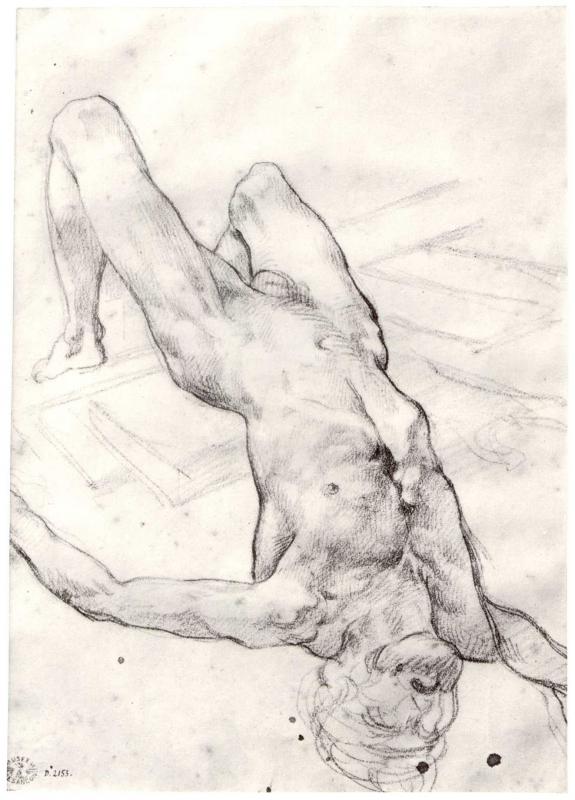
A study for the cadaver Gericault inserted at bottom right of the painting just before it was exhibited at the Salon
When the picture was first exhibited, the catalogue, in deference to the censor, listed it simply as a ”Shipwreck Scene”. But no one had to be told who these men were, or of what disaster the victims. The shipwreck of the frigate ”Medusa” had precipitated a great political scandal, which the government of Louis XVIII had in vain tried to suppress. People saw it as far more than just a maritime disaster. It became a symbol; symptomatic of everything that was wrong with the Bourbon Restoration and the emigre officials who flocked back to France after the fall of Napoleon. The captain of the Medusa, Duroys de Chaumareix, was an aristocrat of the ancien regime who had been a lieutenant in the navy at the outbreak of the French Revolution and had then gone into exile; he had not been to sea for twenty-five years prior to being appointed to its command. His frigate was the flagship of a small squadron ordered to Senegal in 1816 to take formal possession of the African colonies that the British had seized from Napoleon and were restoring to the Bourbons under the Treaty of Paris.
The squadron had hardly left port before De Chaumareix lost contact with his escort vessels. A few days later, on July 2, 1816, he ran his ship aground o a sandbank some seventy miles off the coast of what is now Mauritania. The frigate was loaded with four hundred passengers and crew, nearly double what her lifeboats could hold. Among the passengers were the newly appointed governor of Senegal with his family and members of his staff, two companies of soldiers from a battalion destined for the service in Africa, and a large number of civilians, including twenty-one women.
When the frigate ran aground, her boats might have managed to pull her off had the captain immediately jettisoned the flour in her hold, but this cargo seemed to precious to throw overboard. Then, when the ship began to be battererd to pieces by the waves, the governor sketched out a plan for a raft to be used by the surplus people. All the available spars
timber were lashed together to form a makeshift platform 65 feet long and 23 feet wide.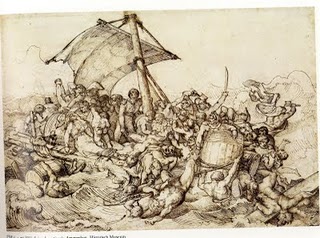
medusa sketch ''In the 1820's, the instability of France reached its peak and violence was rampant. The new uproar from the lower class made it difficult for classicism in any form to succeed. Gericault became engaged and represented this new chaotic and aggressive world with drawings and paintings of poverty and despair which he confronted everyday on the streets.''
At last, on July 5, the order was given to abandon ship. The ladies and gentlemen of quality embarked on the captain’s and the governor’s barges. Most of the naval personnel found seats in the four other lifeboats. That left 149 men and one women, a sergeant’s wife, to be loaded aboard the raft, an operation attended by the high degree of military efficiency for which troop movements are noted. In their hurry to leave, the ship’s officers made no serious efforts to provide this mob with anything to eat ofr drink; the castaways, the dregs, were sent off with only a bag of sea-soaked biscuit, two small casks of water, and, being a French ship, six barrels of table wine.
With 150 people on boards, the raft nearly sank under the weight. Everyone was standing in water up to the waist, and crowded so close to the others that it was hardly possible to take a step, let alone sit or lie down. Ropes had to be rigged to keep the men at the edges from falling overboard even in calm weather. A stubby mast was fitted with a small sail, but it was almost totally useless.
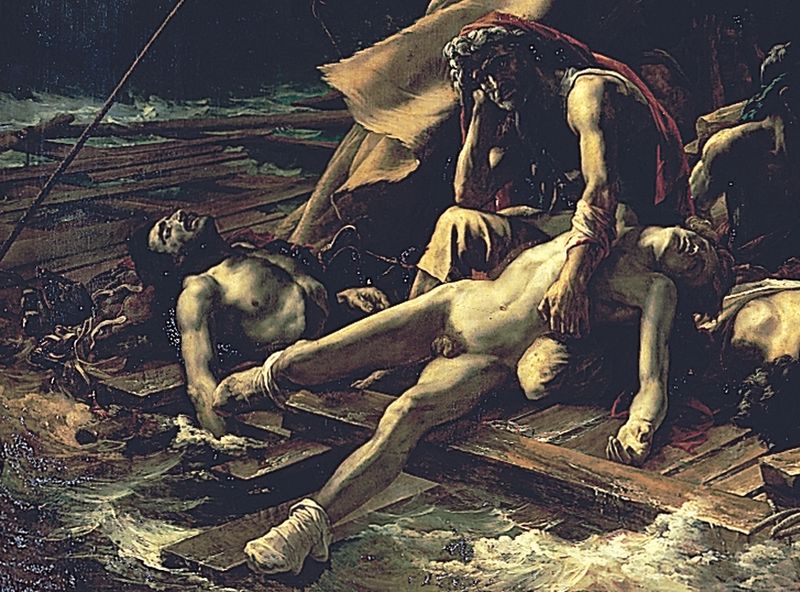
medusa.Detail from The Raft of the Medusa (oil on canvas), held in the Louvre in Paris Date ca. 1818
The four officers on the raft had all declined opportunities in the lifeboats. Among them was Alexander Correard, a civil engineer who had not wanted to abandon the twelve construction workers in his care, and Henri Savigny, one of the ship’s surgeons, who had refused to leave these men without the services of a doctor. It was they who afterward wrote the grimly accusatory ”Account of the Shipwreck of the Medusa” which is the principal source of information about the disaster.
The naval officer ostensibly commanding the raft was an expendable midshipman, Coudin, who had been injured in an accident and was unable to move his legs. His attempts to obtain charts and a sextant had proved fruitless, and when someone afterward had managed to find a pocket compass, it slipped from Coudin’s hands and was lost between the timbers of the raft. Duroys de Chaumareix did not bother with the maritime protocol that the captain is the last to leave the ship; he was off with shouts of ”Vive le Roi !” while there were still seventeen men left on the hull of the frigate. However, most of them were men who had broken into the wine stores and were too wasted to care. The original plan had been for the lifeboats to tow the raft to the nearest point on the African shore.
But, the submerged raft was too unweildy for easy towing and threatened to impede the progress of the boats. Before long, to the horror of the men watching from the raft, one boat after another slipped its towrope, leaving them helplessly adrift on the open sea. A junior lieutenant in one of the small boats tried to protest when he saw a sailor on the captain’s barge drop the line: ”captain take your towrope again,” he shouted, but the captain merely ordered his men to hoist sail and make for the African coast, which was, in fact, so close that it came within sight before sundown.
Savigny and Correard later estimated that the boats could have towed the raft to safety in a couple of days. ”perhaps they would have been forced to foresake us the second night after our departure, if indeed more than thirty-six hours had been required to tow us to land; for the weather was very bad; but we should then have been very near to the coast, and it would have been very easy to save us; at least we should have had only the elements to accuse!”
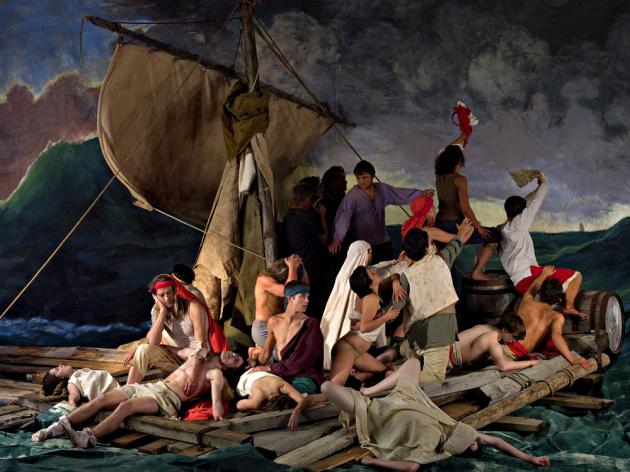
"Tableaux vivants inspired by or involving pre-existing images have become Hannah's stock-in-trade, yet he continues to subtly alter how he approaches and restages history. He typically presents the viewer with projected videos that at first glance appear to be still photographic images. The slight quivering of his models, who are often holding strenuous or otherwise difficult poses, reveals the reality behind the images." (Mark Clintberg, Canadian Art) Fig.1 Adad Hannah 'The Raft of the Medusa' (100 Mile House) 2009 Produced with assistance from the community of 100 Mile House Courtesy Pierre-François Ouellette art contemporain
”The absence of a divinity who watches over the victims of shipwreck appears with particular clarity in Géricault’s Raft of the ‘Medusa’ because, as Eitner suggests, the artist violated certain codes and expectations of the audience. First, the artist broke radically with contemporary art when he created a major public image without traditional religious or political meanings — something especially blatant because he chose a large canvas of the size previously reserved for statements of political and religious belief. Second, Gericault omitted any sort of secular or heavenly divinity, which were conventionally included in such works. The painters of the Napoleonic era, particularly Gros, had glorified the emperor by making scenes of human suffering the setting for imperial pomp.
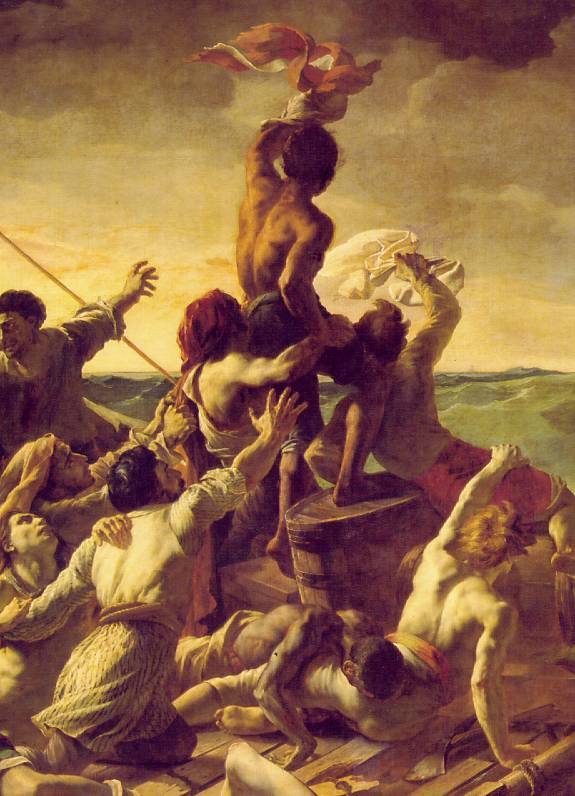
detail. ''Art in the Romantic spirit increasingly centers on the powerful forces of nature, and the belief that emotion is stronger than reason. Romanticists believed that truth could be sought and found in the feeling and emotion of private experience more so than in political or religious doctrine or rules of reason. They believe that reality is defined within the self and not in the external man made environment. The Romanticists' individualism sometimes resulted in his alienation.''
According to Eitner,
Gros made this subordination of human suffering to a higher, political interest naively clear in the horizontal subdivision of his canvases: above the victims of war agonizing in the lower foreground, the Emperor and his retinue pass like a celestial vision .
Géricault omitted from thc Raft all devices fcr placing human suffering in an ideological context.
Its drama has no heros and no message. No God, saint, or monarch presides over the disaster; no common cause is in evidence; no faith, no victory justifies the suffering of the men on the Raft: their martyrdom is one without palm or flag. It is as if Géricault had taken the foreground of human misery from one of the Gros’ pictures and omitted the apotheosis above.
The artist, in other words, makes his point by violating two codes or conventions, the first that large works were reserved for statements of ideological import sanctioned by church or state, and the second that such works which represented human suffering should contain an ideological justification of them. By omitting both expected features, Géricault forcefully created an image of human isolation and helplessness which proclaims the absence of such usual explanations.”
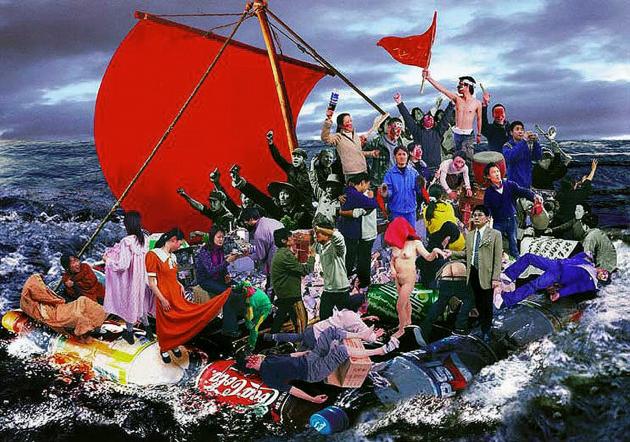
Hu Jieming's "highly acclaimed photo-manipulated images Raft of the Medusa (2002) he references to Théodore Géricault's seminal and allegorical image, the Raft of the Medusa (1819). The historical painting serves as a mytho-poetic memorial of the 150 lost souls onboard the raft after a fatal shipwreck, from which only 15 survived. The painting very elegantly undermines the traditional heroic 19th century historical painting, and, instead, conveys a society in sinking collapse. Hu Jieming parallels this historic occurrence to the regime of the Cultural Revolution with all its sinister cruelty. His Raft of the Medusa, thus, is more than just a reference to the past: The photos are composed of today's excessive amount of consumer goods and advertisement imagery. Additionally, Hu Jieming juxtaposes pictures of today's youth in gestures of self-indulgent hedonism with monochrome grey pictures of the suppressed people in traditional mao-uniforms. These compositions made of images appropriated from different socio-political realities signify a strong critical engagement with both history and the present - it is a concern ranging beyond pure private considerations."
aa


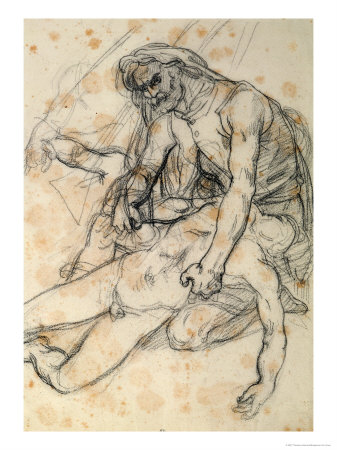




 COMMENTS
COMMENTS
I am intending to re-enact the raft of the medusa on the Thames at Oxford this summer. The exact structure of the raft is available, and I was thinking of using students for the victims/survivors.
No students will be intentionally damaged in the process. Heh.
sounds like a lot of work. hope you will be carry some good insurance coverage on board. Best